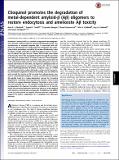| dc.contributor.author | Matlack, Kent E. S. | |
| dc.contributor.author | Tardiff, Daniel F. | |
| dc.contributor.author | Narayan, Priyanka | |
| dc.contributor.author | Hamamichi, Shusei | |
| dc.contributor.author | Caldwell, Kim A. | |
| dc.contributor.author | Caldwell, Guy A. | |
| dc.contributor.author | Lindquist, Susan | |
| dc.date.accessioned | 2014-11-12T14:06:27Z | |
| dc.date.available | 2014-11-12T14:06:27Z | |
| dc.date.issued | 2014-03 | |
| dc.date.submitted | 2013-12 | |
| dc.identifier.issn | 0027-8424 | |
| dc.identifier.issn | 1091-6490 | |
| dc.identifier.uri | http://hdl.handle.net/1721.1/91531 | |
| dc.description.abstract | Alzheimer’s disease (AD) is a common, progressive neurodegenerative disorder without effective disease-modifying therapies. The accumulation of amyloid-β peptide (Aβ) is associated with AD. However, identifying new compounds that antagonize the underlying cellular pathologies caused by Aβ has been hindered by a lack of cellular models amenable to high-throughput chemical screening. To address this gap, we use a robust and scalable yeast model of Aβ toxicity where the Aβ peptide transits through the secretory and endocytic compartments as it does in neurons. The pathogenic Aβ 1–42 peptide forms more oligomers and is more toxic than Aβ 1–40 and genome-wide genetic screens identified genes that are known risk factors for AD. Here, we report an unbiased screen of ~140,000 compounds for rescue of Aβ toxicity. Of ~30 hits, several were 8-hydroxyquinolines (8-OHQs). Clioquinol (CQ), an 8-OHQ previously reported to reduce Aβ burden, restore metal homeostasis, and improve cognition in mouse AD models, was also effective and rescued the toxicity of Aβ secreted from glutamatergic neurons in Caenorhabditis elegans. In yeast, CQ dramatically reduced Aβ peptide levels in a copper-dependent manner by increasing degradation, ultimately restoring endocytic function. This mirrored its effects on copper-dependent oligomer formation in vitro, which was also reversed by CQ. This unbiased screen indicates that copper-dependent Aβ oligomer formation contributes to Aβ toxicity within the secretory/endosomal pathways where it can be targeted with selective metal binding compounds. Establishing the ability of the Aβ yeast model to identify disease-relevant compounds supports its further exploitation as a validated early discovery platform. | en_US |
| dc.description.sponsorship | Howard Hughes Medical Institute (Collaborative Innovation Award) | en_US |
| dc.language.iso | en_US | |
| dc.publisher | National Academy of Sciences (U.S.) | en_US |
| dc.relation.isversionof | http://dx.doi.org/10.1073/pnas.1402228111 | en_US |
| dc.rights | Article is made available in accordance with the publisher's policy and may be subject to US copyright law. Please refer to the publisher's site for terms of use. | en_US |
| dc.source | PNAS | en_US |
| dc.title | Clioquinol promotes the degradation of metal-dependent amyloid-β (Aβ) oligomers to restore endocytosis and ameliorate Aβ toxicity | en_US |
| dc.type | Article | en_US |
| dc.identifier.citation | Matlack, K. E. S., D. F. Tardiff, P. Narayan, S. Hamamichi, K. A. Caldwell, G. A. Caldwell, and S. Lindquist. “Clioquinol Promotes the Degradation of Metal-Dependent Amyloid- (A ) Oligomers to Restore Endocytosis and Ameliorate A Toxicity.” Proceedings of the National Academy of Sciences 111, no. 11 (March 3, 2014): 4013–4018. | en_US |
| dc.contributor.department | Massachusetts Institute of Technology. Department of Biology | en_US |
| dc.contributor.department | Whitehead Institute for Biomedical Research | en_US |
| dc.contributor.mitauthor | Lindquist, Susan | en_US |
| dc.relation.journal | Proceedings of the National Academy of Sciences | en_US |
| dc.eprint.version | Final published version | en_US |
| dc.type.uri | http://purl.org/eprint/type/JournalArticle | en_US |
| eprint.status | http://purl.org/eprint/status/PeerReviewed | en_US |
| dspace.orderedauthors | Matlack, Kent E. S.; Tardiff, Daniel F.; Narayan, Priyanka; Hamamichi, Shusei; Caldwell, Kim A.; Caldwell, Guy A.; Lindquist, Susan | en_US |
| dc.identifier.orcid | https://orcid.org/0000-0003-1307-882X | |
| mit.license | PUBLISHER_POLICY | en_US |
| mit.metadata.status | Complete | |
